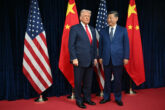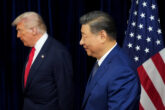October 22, 2015
The Future of the Japan Self-Defense Forces: Implications for the Alliance and Regional Security
The CNAS Asia team recently hosted an experts’ briefing on the future of the Japanese Self-Defense Forces (JSDF). The first of our Alliance Requirements Seminar Series, the event explored how the JSDF is likely to evolve in the coming years as regional circumstances change, and what implications this might hold for the Japan-U.S. alliance. With Japan’s Diet on the eve of passing legislation effectively lifting some self-imposed strictures on the use of force, many of those changes may come sooner rather than later.
Participants included LTG Toshimichi Nagaiwa (Ret.), VADM Yoji Koda (Ret.), LTG Yoshiaki Nakagawa (Ret.), and LTG Yoshikazu Watanabe (Ret.). Discussion began with a recognition that, while the region faced destabilizing pressures from an ascendant Russia and consistently worrying North Korea, participants agreed that the overriding challenge to Northeast Asian security was still managing a more assertive China. What used to be policy of Deng-style “biding one’s time” has turned toward a more aggressive posture under Xi. A Japanese participant pointed to forces exacerbating tensions in the region—Chinese military expansion and routine cyberattacks, economic and strategic claims in the East China Sea, and a deepening Sino-Russian partnership set to “aggravate” existing fissures. The participant then pointed to the uncertain political and diplomatic environment in the region, particularly unease in Japan over South Korea’s posture vis-a-vis China—feelings that have grown with President Park’s perceived friendliness toward China toward China.
The next participant opened by emphasizing the crucial importance of the US-Japan alliance, both culturally and militarily. He asserted that theirs was a “Passport Alliance,” enabling Japan to enter the community of Western democracies and the United States to firmly establish itself as a Pacific power.
Next, a participant then dove into greater depth on the role of the Japanese Self-Defense Forces in countering China’s A2AD strategy and supporting American forces in doing the same. He outlined the crucial capabilities and divisions of labor the two allies pursue, such as a sophisticated Japanese aerial defense regime that frees up American air forces for engagements elsewhere around the globe.
Though strong partners, the retired officer warned of emerging vulnerabilities the US and Japan would have to counter in the future. China’s growing anti-ship capabilities—from ballistic missiles to hypersonic weaponry—were a particular point of concern. Similarly, Chinese abilities to disrupt radio and satellite communications and target American and Japanese digital infrastructure is only growing, he warned, and said he worried that the two countries were only growing more dependent on that infrastructure for both military and civilian purposes.
A participant then recommended that both the American and Japanese forces work to develop technologies to counter these capabilities—their own hypersonic weapons, fleet-based antiballistic missile systems, and similar platforms—as well as preparations to counter conventional Chinese invasions of southwestern islands that would likely follow any initial attack. When pressed, he admitted that these could be investments of substantial political and budgetary cost, but pointed to better-integrated command and control infrastructure (namely one that could hold crisis-level bandwidth, not just exercise-level) as lower-hanging fruit of great importance.
A retired officer then reiterated Japanese strategic unease over the ROK appearing to grow closer to China. He cited a sort of capabilities mismatch on Korea’s part in the US-Japan-ROK relationship, stressing that more strategic mission sharing would be necessary in the future. While understanding of the present political climate deterring building capabilities that would threaten the warming relations with China, he still observed a trend among younger ROK command officers (“O-5, O-6 or so”) toward recognizing China as the most likely rival of the future.
Finally, participants focused in on the need for conventional capabilities Koda raised to defend the southwestern (Ryukyu) islands. Emphasizing JSDF policy to defend the islands or take them if occupied, each emphasized the strategic importance of the islands (they are home to many airfields) but also how they represent substantial tactical “bottlenecks” for the movement of enemy forces.
More from CNAS
-
Chinese Maker of Bitcoin-Mining Machines Is a Security Threat, Says Expert
Bloomberg News reports that a Chinese manufacturer, Bitmain Technologies Ltd, that sells most of the world’s Bitcoin-mining machines — including 16,000 of them to a venture ba...
By David Feith
-
Indo-Pacific Security / Energy, Economics & Security
North Korea’s Provocations, Power Plays, and Shifting AlliancesTensions on the Korean Peninsula have reached a new and dangerous threshold. President Lee Jae Myung is warning of a real risk of accidental military clashes, as the situation...
By Dr. Go Myong-Hyun
-
Indo-Pacific Security / Energy, Economics & Security
How to Win the Economic War with ChinaTrump's approach to China has run aground, giving Beijing unprecedented advantage in the economic conflict....
By Edward Fishman & Julian Gewirtz
-
Indo-Pacific Security / Technology & National Security
Sharper: Tech + ChinaRecent talks between President Donald Trump and Chinese Communist Party General Secretary Xi Jinping placed a spotlight on emerging technologies, from high-end chips to minera...
By Charles Horn & Sevi Silvia




